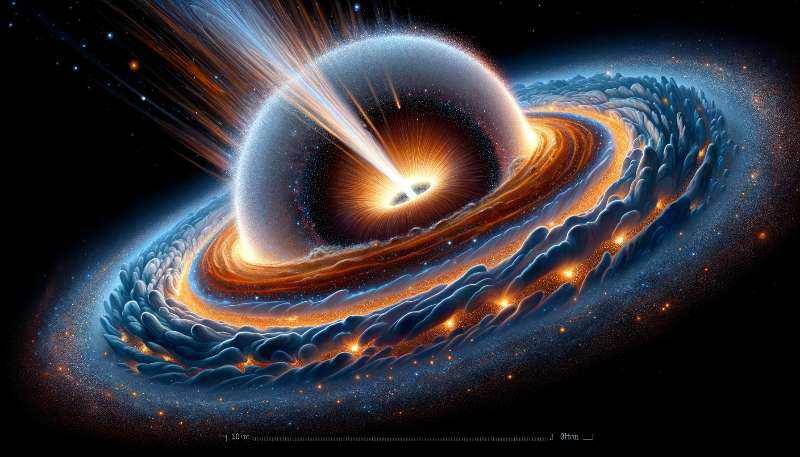
An international team of astronomers has discovered a previously unknown source of dust in the universe — a Type Ia, or thermonuclear, supernova interacting with gas from its surroundings — bringing them one step closer to understanding the circle of life and death on a cosmic level.
Cosmic dust is similar to dust on Earth in that it is formed by groupings of molecules that have condensed and stuck together as single grains. While the exact nature of cosmic dust creation has long been a mystery, experts agree on one thing: There is too much of it in the early universe to have been formed exclusively by stars.
“The formation of cosmic dust is of critical importance in astronomy,” said Texas A&M University astronomer Dr. Lifan Wang, one of three co-first authors of the research study published Friday (Feb. 9) in Nature Astronomy. “It is related to literally all phenomena of the cosmos. Understanding the process by which it forms has been one of the key objectives of many modern-day astronomical missions.”
Although supernovae have been known to play a role in dust formation, Wang notes that to date, dust formation has only been seen in core-collapse supernovae, the explosions of massive stars. Because core-collapse supernovae do not occur in elliptical galaxies — ones that aren’t organized in spiral patterns like our own Milky Way galaxy but instead are giant swarms of stars — the nature of dust creation there has remained elusive. Wang says the results of the team’s study are significant because they indicate that thermonuclear supernovae, which occur as a result of the explosion of a white dwarf star in a binary system with another star, may account for a significant amount of dust in these galaxies.
“All life forms in the universe are cosmic dust forged in processes related to stellar evolution,” said Wang, a member of the Texas A&M Department of Physics and Astronomy and the George P. and Cynthia Woods Mitchell Institute for Fundamental Physics and Astronomy since 2006. “Our paper presents clear evidence of the condensation of a massive amount of dust particles after the explosion of a white dwarf star.”
The researchers monitored a supernova, SN 2018evt, for more than three years using a combination of space-based facilities such as NASA’s Spitzer Space Telescope and NEOWISE missions and ground-based facilities, including the Las Cumbres Observatory’s global network of telescopes and similar facilities in China, South America and Australia. They found that the supernova was running into material previously cast off by one or both of the stars in the binary system before the white dwarf star exploded, sending a shock wave into this pre-existing gas.
As the researchers monitored the supernova during the course of more than 1,000 days, they noticed that, while its light began to dim precipitously in the optical wavelengths perceptible to the naked eye, it started glowing brighter in infrared light — a telltale sign that dust was being created in the circumstellar gas as it cooled following the supernova shock wave passing through it.
“The origins of cosmic dust have long been a mystery,” said Dr. Lingzhi Wang, an associate researcher at the Chinese Academy of Sciences South America Center for Astronomy in Chile and first author as well as corresponding author of the team’s study. “This research marks the first detection of a significant and rapid dust formation process in the thermonuclear supernova interacting with circumstellar gas.”
Based on their data modeling, the team estimates that a large amount of dust — more than 1% of the mass of the sun — must have been created. As the supernova continues to cool over time, they predict the amount of dust created should increase, perhaps tenfold.
While these dust factories aren’t as numerous or efficient as core-collapse supernovae, Texas A&M’s Wang says there may be enough of these thermonuclear supernovae interacting with their surroundings to be a significant or even dominant source of dust in elliptical galaxies.
“This work offers insights into the contribution of thermonuclear supernovae to cosmic dust and more such events may be expected to be found in the era of the James Webb Space Telescope,” Wang added. “The Webb Telescope sees infrared light, which is perfect for the detection of dust.”
Wang and his research group at Texas A&M contributed critical observational data taken by the Spitzer Space Telescope. The data showed a dramatic brightening in the infrared wavelength about one year after the supernova explosion — an increase in brightness that offers definitive proof of dust condensation.
Dr. Andy Howell, an astronomer at Las Cumbres Observatory and adjunct professor at the University of California, Santa Barbara, is principal investigator of the Global Supernova Project, whose data was used in the study.
“The creation of dust is just gas getting cold enough to condense,” Howell said. “One day, that dust will condense into planetesimals and, ultimately, planets. This is creation starting anew in the wake of stellar death. It is exciting to understand another link in the circle of life and death in the universe.”
About Research At Texas A&M University
As one of the world’s leading research institutions, Texas A&M is at the forefront in making significant contributions to scholarship and discovery, including in science and technology. Texas A&M ranked 23rd in the National Science Foundation’s most recent Higher Education Research and Development Survey based on annual expenditures of more than $1.153 billion in fiscal year 2022. Texas A&M’s research creates new knowledge that provides basic, fundamental and applied contributions resulting, in many cases, in economic benefits to the state, nation and world. To learn more, visit Research@Texas A&M.

